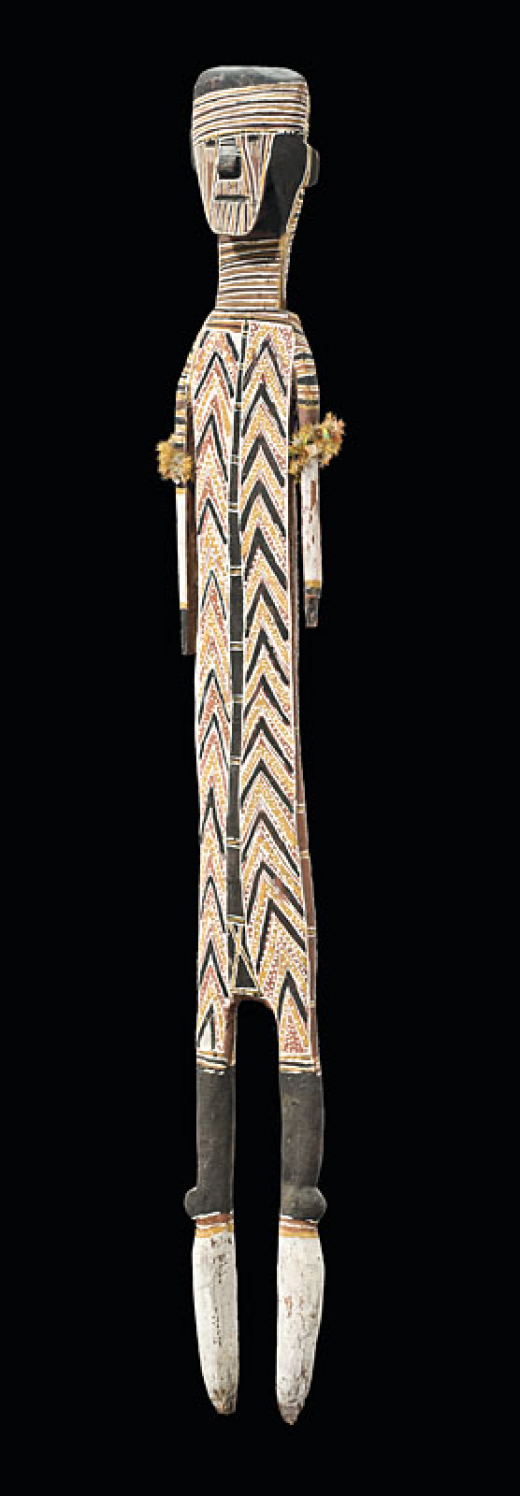Artist Unknown, MOKUY FIGURE
Artist Unknown, MOKUY FIGUREEstimate $70,000 – $100,000
natural earth pigments on carved wood, lorikeet feathers, cane binding
HEIGHT: 137CM
Provenance:
Executed at Milingimbi, Central Arnhem Land in the early 1960s
Gabrielle Pizzi Collection
Exhibited:
Aratjara: Art of the First Australians, Kunstsammlung Nordrhein-Westfalen, Düsseldorf, 24 April-4 July 1993; Hayward Gallery, London, 23 July-10 October 1993, Louisiana Museum, Humlebaek, 11 February-23 May 1994, National Gallery of Victoria, Melbourne, 23 June-15 August 1994
Literature:
Bernhard Lüthi et al., Aratjara: Art of the First Australians, Cologne: Dumont, 1993, p.160, cat.no.30 (illus.)
Cf. For an analysis of similar mokuy and other spirit figures in the J.A. Davidson Collection at the National Museum of Australia, see J. Hoff, ‘Aboriginal carved and painted human figures in north-east Arnhem Land,' in P.J. Ucko, (ed.), Form in Indigenous art: Schematisation in the art of Aboriginal Australia and prehistoric Europe, Canberra: Australian Institute of Aboriginal Studies, 1977, pp.156-164. See also R.M. Berndt, ‘Australian Aboriginal Sculpture,' in R.M. Berndt, and E.S. Phillips (eds.), The Australian Aboriginal Heritage, Sydney: Ure Smith, 1973, pp.156-185.
Naturalistic mortuary figures of mokuy made in eastern Arnhem Land are derived from square-sectioned and painted grave post figures called wuramu, which in turn were influenced by the grave posts of the Macassans who visited the shores of Arnhem Land for some 400 years up to the beginning of the 20th century. In Yolngu languages, a mokuy is a ghost or the sinister aspect of the spirit of a deceased person. Mokuy inhabit the vicinity of the burial ground and are liable to harm those who venture close by. Yolngu go to great lengths to avoid disturbing these spirits.
The figure by Lipundja (lot 35) bears the characteristic diamond pattern of the Yirritja moiety Honey or Sugarbag ancestor of the Gupapuyngu clan. Such figures are also known by the term murayana, meaning a spirit that roams about.
The Artist Unknown figure (lot 34) bears the Ganalbingu clan chevron pattern associated with lunggurrma, the north-east wind which blows from October to December and brings the monsoons to Arnhem Land. This design also belongs to the Yirritja moiety. Hoff identifies two forms of so-called ‘archaic' Ganalbingu clan mokuy: those ""with the 'ribs and flesh' decoration"" which ‘serves as a receptacle for a dead man's spirit'; and those which feature the yam or butterfly design. This work belongs to the former category. Characteristic features of these mokuy are the practically identical designs on front and back; the painted design is divided vertically and extends from the neck to the knees; and they have small facial features. Hoff suggests that these ‘archaic' figures derive from ‘earlier bound bark figures rather than the Macassan grave posts' (Hoff, 1977, p.158).
The third figure (lot 36) features a pointed chin characteristic of Macassan beards or goatees, raised ‘ears', ceremonial markings across the forehead with the torso covered in ritual body painting designs belonging to clans of the Dhuwa moiety. The vertical rectangle painted on the figure's chest most likely represents a clan waterhole and symbolises the connection between the deceased and the land from which their spiritual identity emanates; the clan waterhole is not only the repository of the souls of yet-to-be-born clan members, but also of their spirits after death.
The mokuy figures by Lipundja (lot 35) and by the unknown artist (lot 34) appear in a photograph taken by Alan Fidock outside the Milingimbi craft shop in the 1960s, reproduced in Djon Mundine, et al., The Native Born: Objects and representations from Ramingining, Arnhem Land, Sydney: Museum of Contemporary Art, 1999, p.66. Mr Fidock was a teacher at Milingimbi during the 1960s with responsibility for the distribution of the art and artefacts produced on the island.



